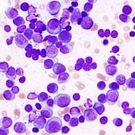What is Multiple Myeloma?
Updated: Jul 17, 2009

Multiple myeloma (also called myeloma or plasma cell myeloma) is a cancer of the plasma cells. Plasma cells are an important component of the immune system and are typically found in the bone marrow.
When functioning properly, plasma cells produce a variety of infection-fighting proteins called antibodies, or immunoglobulins. When a person has multiple myeloma, however, their plasma cells begin overproducing one type of abnormal antibody. This antibody is referred to as a monoclonal (M) protein. Monoclonal proteins cannot effectively fight infections. In addition, the growth of myeloma cells may inhibit the production of normal blood cells, and therefore normal immunoglobulins, due to overcrowding of the bone marrow.
As abnormal plasma cells proliferate, they may form tumors called plasmacytomas. Plasmacytomas can be found wherever bone marrow is active, particularly the rib cage, the bones of the shoulder, the hip, and the spine. They may occur in multiple locations at one time, which is why the disease is called multiple myeloma.
Related Articles:
- None Found
